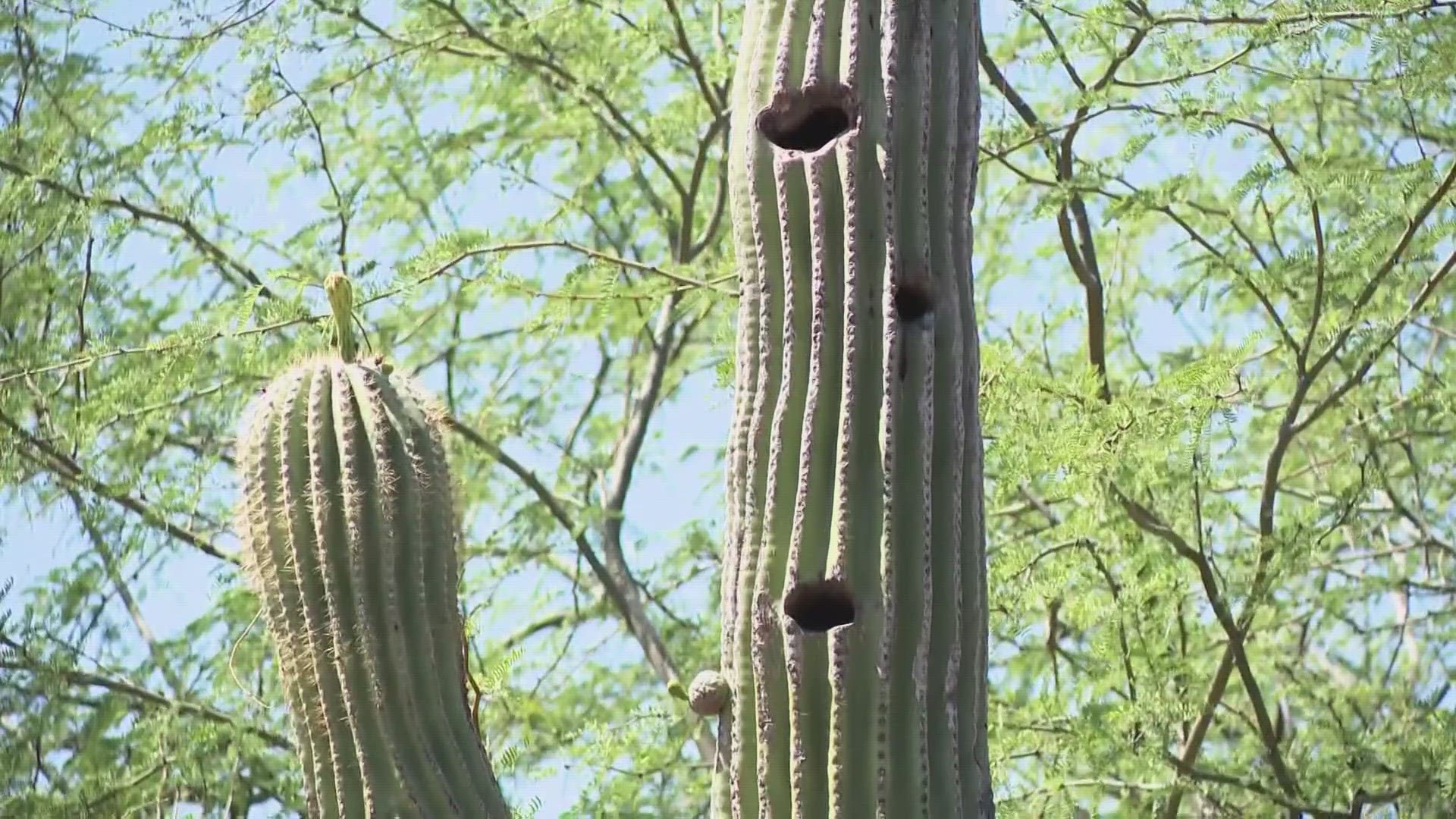PHOENIX — >>Editor's note: The above video is from a previously aired broadcast.
If you can't handle the heat this summer, don't feel bad. Phoenix's saguaro cacti, iconic of Arizona, can't take it either.
Phoenix metro's urban heat island has temperatures so hot that cacti are suffocating. Residents all over the Valley are dealing with saguaros in their yards dropping arms and falling over dead.
It looks grim, but the situation isn't hopeless. While saguaro skeletons can be a money making venture, homeowners looking to protect their plants still have options available to them. 12News sat down with Angelica Elliott, the Desert Botanical Garden's Assistant Director of Public Horticulture to find out how you can save your saguaros.
The big three tips?
- Increase the natural biodiversity of your yard and get some shade plants
- Use a 30-60% coverage loose-woven shade cloth around the base of the cactus
- Water only when your cactus needs it, and water carefully
Here's a deeper look at each of those points:
Make your yard more like the desert
It sounds strange at first, but making your yard more like a natural desert will go a long way to keeping things cool.
Materials like decomposed gravel and river rock will trap heat and radiate it overnight. And without shade plants near your saguaro to keep the ground cool, the effect is only more extreme. Fortunately, landscaping doesn't have to break the bank.
"I would start by trying to mimic nature," Elliott recommended. "I would plant some small shrubs, drought tolerant or native shrubbery. There's plenty of them that are available like brittlebush or sage."
These plants are found naturally around saguaros, she said, and absorb heat but don't transfer it back out to their surroundings. They don't need much water, and seeds or clippings are cheaply available.
She suggests taking a look at where saguaros grow outside of the Phoenix metro for inspiration.
Use a loosely wrapped, permeable shade cloth
One of the early warning signs that a saguaro isn't doing well is a yellowish discoloration around the base or arms of the plant. That's an indication of sun damage, and means that the plant needs more cover than it's getting.
In that case, a shade cloth wrapped lightly around the base of the saguaro can go a long way towards keeping it healthy.
She says to use a shade cloth rated between 30% to 60% coverage, and look for one with a loose, open weave. If it's tightly woven, it will absorb too much heat, and will suffocate the cactus. Wrap it loosely around the saguaro so as not to damage the spines, and only go as high as you can reasonably reach from the ground.
"Lightly wrap it and just keep it on. You might have to keep it on until mid October, you know, when the temperature starts to cool off."
To water, or not to water, that is the question
And what a complicated question it is. Saguaros have a... Weird relationship with water.
They're adapted to soak up moisture during monsoon storms, but too much of it can cause their roots to rot. They can dehydrate and look shriveled, but looking shriveled doesn't always mean they're dehydrated. By the way, don't hose it down directly or you could make the plant sick.
So... What are you supposed to do? In short, it depends.
"You have to take a balanced approach," Elliott said. "Don't water just because your neighbor said to water." Every yard, and every saguaro, has different needs.
When a saguaro is hydrated, it will look plump and full. The ridges on the stem, known as pleats, will expand "like an accordion" and spread apart. If that's the case? Don't water.
But seeing the pleats closer together doesn't necessarily mean the plant is dehydrated. Elliott recommends checking the moisture in the soil around the cactus. It may still be absorbing water from the ground. Over watering can even lead to root rot and damage the supporting structures of the cactus, Elliott explained.
Saguaros really only need watering during hot summer months -- when they typically absorb rainfall from monsoons. If you need to water your saguaro, don't spray the plant directly. Moistening the skin can prevent damaged areas (such as woodpecker holes or general abrasions) from drying out and healing over. Instead, run a low flow over the ground in a 2-4 foot circle around the saguaro. Saguaro roots can spread as far as the plant is tall, and that's where you want the water to go.
Elliott recommends watering once a month during the hottest times of the year if monsoon storms don't rain on your yard.
More resources
>> Download the 12News app for the latest local breaking news straight to your phone.
HEAT BEAT
Here are several videos about Arizona's extreme heat and how you can stay safe during the state's summer months.

